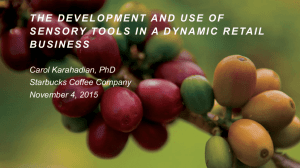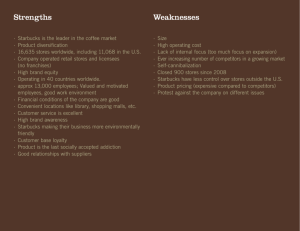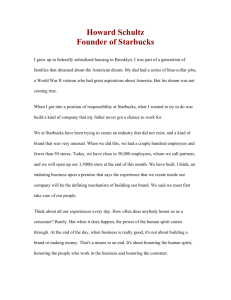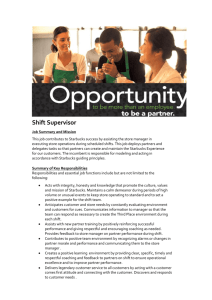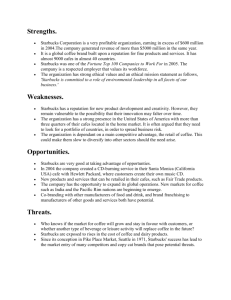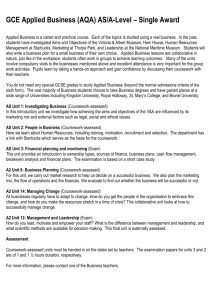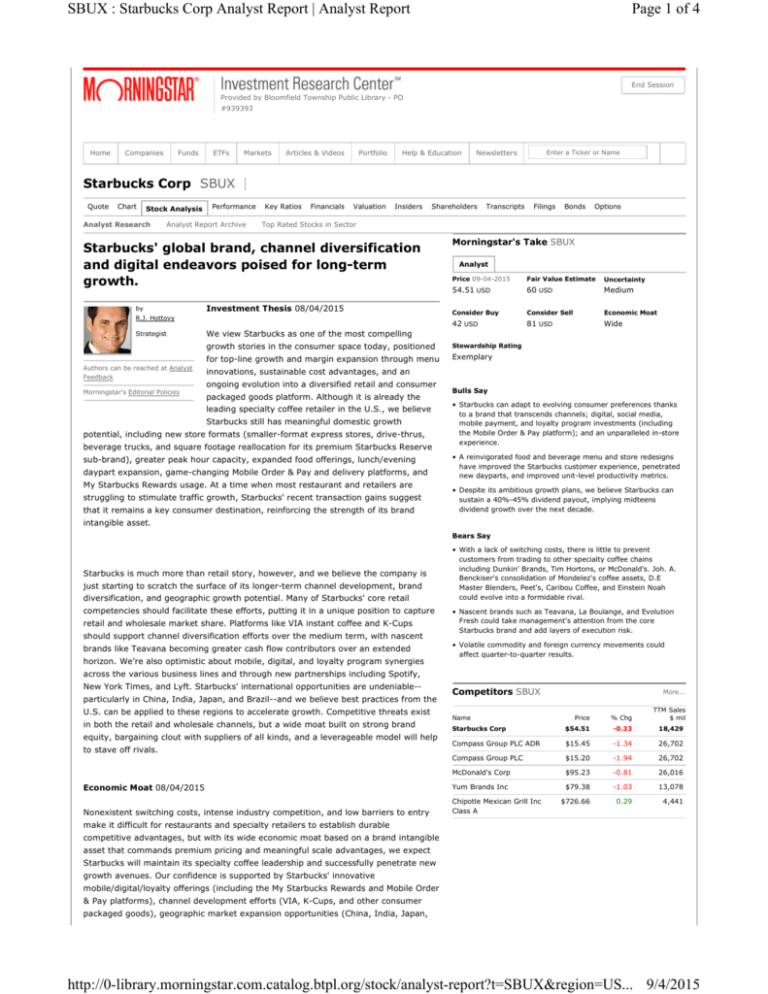
SBUX : Starbucks Corp Analyst Report | Analyst Report
Page 1 of 4
End Session
Provided by Bloomfield Township Public Library - PO
#939393
Home
Companies
Funds
ETFs
Markets
Articles & Videos
Portfolio
Help & Education
Enter a Ticker or Name
Newsletters
Starbucks Corp SBUX
Quote
Chart
Stock Analysis
Analyst Research
Performance
Analyst Report Archive
Key Ratios
Financials
Valuation
Insiders
Shareholders
by
R.J. Hottovy
Investment Thesis 08/04/2015
Strategist
We view Starbucks as one of the most compelling
Morningstar's Editorial Policies
Filings
Bonds
Options
Top Rated Stocks in Sector
Starbucks' global brand, channel diversification
and digital endeavors poised for long-term
growth.
Authors can be reached at Analyst
Feedback
Transcripts
Morningstar's Take SBUX
Analyst
Price 09-04-2015
Fair Value Estimate
Uncertainty
54.51 USD
60 USD
Medium
Consider Buy
Consider Sell
Economic Moat
42 USD
81 USD
Wide
growth stories in the consumer space today, positioned
Stewardship Rating
for top-line growth and margin expansion through menu
Exemplary
innovations, sustainable cost advantages, and an
ongoing evolution into a diversified retail and consumer
packaged goods platform. Although it is already the
leading specialty coffee retailer in the U.S., we believe
Starbucks still has meaningful domestic growth
potential, including new store formats (smaller-format express stores, drive-thrus,
beverage trucks, and square footage reallocation for its premium Starbucks Reserve
sub-brand), greater peak hour capacity, expanded food offerings, lunch/evening
daypart expansion, game-changing Mobile Order & Pay and delivery platforms, and
My Starbucks Rewards usage. At a time when most restaurant and retailers are
struggling to stimulate traffic growth, Starbucks' recent transaction gains suggest
that it remains a key consumer destination, reinforcing the strength of its brand
Bulls Say
• Starbucks can adapt to evolving consumer preferences thanks
to a brand that transcends channels; digital, social media,
mobile payment, and loyalty program investments (including
the Mobile Order & Pay platform); and an unparalleled in-store
experience.
• A reinvigorated food and beverage menu and store redesigns
have improved the Starbucks customer experience, penetrated
new dayparts, and improved unit-level productivity metrics.
• Despite its ambitious growth plans, we believe Starbucks can
sustain a 40%-45% dividend payout, implying midteens
dividend growth over the next decade.
intangible asset.
Bears Say
Starbucks is much more than retail story, however, and we believe the company is
just starting to scratch the surface of its longer-term channel development, brand
diversification, and geographic growth potential. Many of Starbucks' core retail
competencies should facilitate these efforts, putting it in a unique position to capture
retail and wholesale market share. Platforms like VIA instant coffee and K-Cups
should support channel diversification efforts over the medium term, with nascent
brands like Teavana becoming greater cash flow contributors over an extended
horizon. We're also optimistic about mobile, digital, and loyalty program synergies
• With a lack of switching costs, there is little to prevent
customers from trading to other specialty coffee chains
including Dunkin' Brands, Tim Hortons, or McDonald's. Joh. A.
Benckiser's consolidation of Mondelez's coffee assets, D.E
Master Blenders, Peet's, Caribou Coffee, and Einstein Noah
could evolve into a formidable rival.
• Nascent brands such as Teavana, La Boulange, and Evolution
Fresh could take management's attention from the core
Starbucks brand and add layers of execution risk.
• Volatile commodity and foreign currency movements could
affect quarter-to-quarter results.
across the various business lines and through new partnerships including Spotify,
New York Times, and Lyft. Starbucks' international opportunities are undeniable-particularly in China, India, Japan, and Brazil--and we believe best practices from the
U.S. can be applied to these regions to accelerate growth. Competitive threats exist
Competitors SBUX
TTM Sales
$ mil
Price
% Chg
Starbucks Corp
$54.51
-0.33
18,429
Compass Group PLC ADR
$15.45
-1.34
26,702
Compass Group PLC
$15.20
-1.94
26,702
McDonald's Corp
$95.23
-0.81
26,016
Economic Moat 08/04/2015
Yum Brands Inc
$79.38
-1.03
13,078
$726.66
0.29
4,441
Nonexistent switching costs, intense industry competition, and low barriers to entry
Chipotle Mexican Grill Inc
Class A
in both the retail and wholesale channels, but a wide moat built on strong brand
equity, bargaining clout with suppliers of all kinds, and a leverageable model will help
to stave off rivals.
Name
More...
make it difficult for restaurants and specialty retailers to establish durable
competitive advantages, but with its wide economic moat based on a brand intangible
asset that commands premium pricing and meaningful scale advantages, we expect
Starbucks will maintain its specialty coffee leadership and successfully penetrate new
growth avenues. Our confidence is supported by Starbucks' innovative
mobile/digital/loyalty offerings (including the My Starbucks Rewards and Mobile Order
& Pay platforms), channel development efforts (VIA, K-Cups, and other consumer
packaged goods), geographic market expansion opportunities (China, India, Japan,
http://0-library.morningstar.com.catalog.btpl.org/stock/analyst-report?t=SBUX&region=US... 9/4/2015
SBUX : Starbucks Corp Analyst Report | Analyst Report
Page 2 of 4
and Brazil in particular), and its complementary brand portfolio (Teavana, La
Boulange, and Evolution Fresh), which provide visibility for average annual revenue
growth in the low double digits and cash flow growth in the mid- to high teens over
the next decade. Although there are certainly execution and brand saturation risks
tied to management's loaded agenda, we believe Starbucks' initiatives, if executed
properly, could fortify its already wide economic moat.
With more than 12,300 company-owned and licensed locations in the U.S., Starbucks
maintains a sizable lead over direct domestic rivals, including Dunkin' Donuts (8,200
U.S. points of distribution), Caribou Coffee, and Peet's Coffee (the last two chains,
which account for a few hundred locations, are now owned by the Joh. A. Benckiser
Group). With cafe-like environments and a brand that evokes a high-quality customer
experience, Starbucks enjoys pricing power advantages over most specialty coffee
peers, which we believe will only be augmented by the incubation of the Starbucks
Reserve sub-brand to distribute exclusive, higher-end coffee blends. New product
platforms such as smoothies and tea as well as a revamped food program have
added diversity to the menu, allowing the firm to broaden its target audience,
increase its average transaction size, and expand more into the lunch and evening
daypart. Starbucks also wields considerable influence over arabica coffee bean
suppliers, ensuring access to raw materials at competitive prices. In addition, retail
landlords often grant Starbucks exclusive leases to prominent locations rife with
consumer traffic, and we believe the company has a significant longer-term
opportunity through the use of alternative store formats, including smaller-format
express stores (400-600 limited service locations in high foot traffic locations), standalone drive-thrus, beverage trucks (which have been tested on college campuses),
and kiosk locations. The company's strong landlord relationships and square footage
creativity could accelerate the global growth aspirations of Starbucks' more nascent
retail concepts over the next decade and make it more difficult for rivals to compete.
Many of Starbucks' competitive advantages also apply to international markets, which
we view as a critical growth engine over the next several decades. With a widely
recognized brand, Starbucks is among the few retail concepts to be successfully
replicated across the globe. As such, we believe the firm will eventually exceed its
domestic store count overseas. The chain is has more than 10,000 units outside the
U.S. in more than 60 countries, including some well-established cafe cultures.
Emerging-market prospects are also intriguing, including opportunities in markets
such as mainland China (which already has over 1,500 units, on its way to 3,400 by
2019, and possibly 10,000 over a longer horizon), as well as Brazil and India (which
offer potential for at least a thousand units apiece over the next decade, in our view).
We view Starbucks' 2014 decision to buy the remaining 60.5% stake of Starbucks
Japan that it didn't own favorably, as full ownership should help to accelerate inroads
into new channels (with emphasis on the underpenetrated ready-to-drink market but
also other licensing and food-service opportunities), roll out new brands (Teavana, in
particular), and accelerate mobile/digital/loyalty efforts, which in turn should help to
build on Starbucks Japan's already strong store-level profit metrics (low- to mid20%).
Starbucks' channel development aspirations underscore the power of its brand
intangible asset. We view the company as one of the few food-service operators that
could evolve into a world-class consumer packaged goods company due to its ability
to connect with grocery and mass-channel customers through licensed on-premise
stores. With its already strong bargaining clout with national retailers like Costco,
Kroger, Whole Foods, and Trader Joe's, we expect Starbucks to develop national
distribution of its entire consumer product portfolio over the next few years. With
consumer packaged goods penetration in more than 40 countries (which has more
than doubled the past three years), Starbucks should also have ample opportunities
to expand its presence on grocery and mass-channel shelves across the globe. We've
been impressed by Starbucks' efforts to expand its distribution beyond traditional
outlets, including other restaurant chains, hotels, and airlines.
Continued market share gains in the $8 billion-plus premium single-serve coffee
category, including VIA and the company's K-Cup partnership with Green Mountain,
will likely be the key near-term driver for the channel development segment.
However, with Starbucks Refreshers energy drinks, cold carbonated Fizzio drinks, and
the long-term potential of new food, juice, tea and products stemming from La
Boulange, Evolution Fresh, and Teavana, respectively, we remain comfortable
forecasting low-double-digit collective average annual revenue growth for the channel
development and other segments over the next five years, especially when factoring
http://0-library.morningstar.com.catalog.btpl.org/stock/analyst-report?t=SBUX&region=US... 9/4/2015
SBUX : Starbucks Corp Analyst Report | Analyst Report
Page 3 of 4
in the distribution infrastructure already in place. More important, we anticipate that
the channel development segment will become an increasingly important free cash
flow contributor. Even with the marketing and labor costs necessary to support new
product launches, we anticipate that this segment will continue to see margin
expansion in the years to come, with our model calling for gradual segment margins
exceeding 40% by fiscal 2018.
Valuation 08/04/2015
We're raising our fair value estimate to $60 per share from $55 after the company's
strong third-quarter results, a modest increase in our near-term revenue growth and
margin assumptions stemming from the upcoming initiatives (Mobile Order & Pay,
Starbucks Reserve, delivery, and international channel development partnerships),
and a slight adjustment to our cost of capital assumption to account for recent debt
issuances. Our fair value estimate still incorporates management's ambitious yet still
achievable five-year targets and implies fiscal 2016 price/earnings of 31 times,
enterprise value/EBITDA of 16 times, and free cash flow yield of 3%. Shares may
appear lofty at 37 times the midpoint of management's adjusted fiscal 2015 EPS
guidance ($1.57-$1.58), but we believe a premium is justified given the firm's unique
growth and margin expansion story among large-cap consumer stocks. Despite an
uneven consumer spending backdrop, we find most of management's 2015 guidance
as realistic, including top-line growth of 16%-18%, mid-single-digit comps, 1,650 net
new stores (8% unit growth), and flat to modest growth in adjusted operating
margins (versus 18.6% in fiscal 2014). Our model assumes 17% top-line growth,
driven by 7% consolidated comps (including 7% comps in the Americas, 3% in EMEA,
and 11% in China/Asia Pacific), 1,650 net new locations globally, and 11% growth in
the channel development segment. Our comp assumption is based on steady traffic
improvement as well as a modest increase in the average transaction size due to new
food offerings. Over the next 10 years, we anticipate average annual revenue growth
of 11%, driven by new sales channels, geographic expansion, and licensed store
openings. Our model assumes 2,000 annual net new store openings the next 10
years (including nascent brands), putting Starbucks on track for a global store base
of 41,800 locations by the end of fiscal 2024 (7% annual unit growth). Recent
profitability gains demonstrate the leverageable nature of Starbucks' model as well as
supply chain efficiencies. Our model calls for mild adjusted operating margin
contraction in fiscal 2015 as technology and marketing investments offset increased
expense leverage and improved channel development margins. Longer term, we
believe operating margins in the low to mid-20s are achievable through expense
leverage, wholesale penetration, and licensing arrangements.
Risk 08/04/2015
Starbucks faces increased competition on several fronts, including Dunkin' Brands'
ambitious growth plans, McDonald's emphasis on the coffee and other beverage
categories, increased competition from Jacobs Douwe Egberts (which combines the
coffee assets of Mondelez, D.E Master Blenders, Peet's, Caribou Coffee, and the
Einstein Noah Restaurant Group under the Joh. A. Benckiser Group umbrella), and an
influx of specialty coffee programs at quick-service and fast-casual restaurant chains.
Given its position as a more affluent consumer brand, discretionary spending
headwinds could periodically create periods of top-line volatility. Coffee and dairy
commodity cost volatility can influence profitability, as well as labor and occupancy
cost inflation. Starbucks faces heightened economic, legal, and political risk
associated with its international expansion efforts. The company has also taken on
multiple layers of execution risk (including the further development of VIA Instant
coffee and K-Cups; integration and further development of the Teavana, La Boulange,
and Evolution Fresh brands; and the rollout of Mobile Order & Pay and delivery
initiatives).
Management 08/04/2015
Starbucks Chairman Howard Schultz returned to the role of CEO in January 2008.
Although we typically prefer the roles of chairman and CEO to be split for corporategovernance purposes, we believe the presence of Schultz, who previously served as
CEO from 1987 to 2000, has helped reinvigorate the firm the past several years. In
fiscal 2014, Schultz received $1.5 million in base salary, which seems reasonable
http://0-library.morningstar.com.catalog.btpl.org/stock/analyst-report?t=SBUX&region=US... 9/4/2015
SBUX : Starbucks Corp Analyst Report | Analyst Report
Page 4 of 4
given the firm's impressive fundamentals the past several years. However, Schultz
also was given stock awards, option awards, and nonequity incentive plan
compensation of $20.0 million, which strikes us as moderately excessive relative to
industry peers, even after factoring in the company's strong financial results. With a
3% stake of Starbucks' common shares, Schultz has sufficient incentive to increase
shareholder value, in our opinion. Although we disapprove of certain takeover
defenses, we assign Starbucks an Exemplary Stewardship Rating. We also remain
impressed that, unlike many companies in the consumer cyclical space, Starbucks
has shown a willingness to invest in high-growth potential projects like Evolution
Fresh, La Boulange, Teavana, and the purchase of the remaining 60.5% stake of
Starbucks Japan that it didn't own while still returning cash to shareholders through
dividends and buybacks.
In January 2015, Starbucks announced that Kevin Johnson, current board member
and former CEO of Juniper Networks, would assume the role of president and COO.
He is replacing Troy Alstead. While we believe Alstead added stability to
management's admittedly loaded strategic agenda when he assumed the post in
January 2014, we're optimistic about Johnson's ability to support the company's
current growth projects. In particular, we're encouraged by Johnson's consumer
technology background, which we view as a key asset in expanding the company's
already-leading digital platform across channels and geographies in the years to
come. While Alstead's sabbatical and Johnson's appointment raise natural questions
about eventual succession plans, we continue to view Starbucks as having one of the
deepest benches in the consumer cyclical segment, with several innovative leaders
capable of pushing forth the strategic priorities in the years to come.
Overview
Profile:
Through a global chain of more than 22,500 company-owned and licensed stores,
Starbucks sells coffee, espresso, teas, cold blended beverages, food, and accessories.
The company also distributes packaged and single-serve coffee, tea, juice, and
pastries through its own stores, grocery store chains, and warehouse clubs under the
Starbucks, Teavana, Tazo, Evolution Fresh, La Boulange, and Seattle's Best Coffee
brands. In addition, Starbucks markets bottled beverages, ice creams, and liqueurs
through various partnerships.
S&P 500 index data: S&P 500 Copyright @ 2015
All data from Morningstar except U.S. intraday real-time exchange quotes, which are provided by BATS when
available. End-of-day quotes for Nasdaq, NYSE, and Amex securities will appear 15 minutes after close. Graph
times are Eastern Standard. @ Copyright 2015 Morningstar, Inc.
Contact us. Please read our User's Agreement and Troubleshooting documents.
©2015 Morningstar, Inc. All rights reserved.
http://0-library.morningstar.com.catalog.btpl.org/stock/analyst-report?t=SBUX&region=US... 9/4/2015

